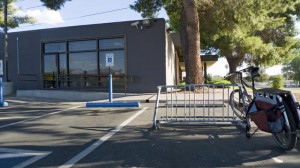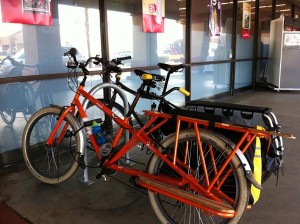 After months of meetings and a city council vote rejecting a bike parking code update, it took a group of about 12 two and half hours Monday night to agree on a compromise to the contentious code update.
After months of meetings and a city council vote rejecting a bike parking code update, it took a group of about 12 two and half hours Monday night to agree on a compromise to the contentious code update.
Members of the Tucson-Pima County Bicycle Advisory Committee, developers, bicycle planners from the city and county and staff in the land-use department spent Monday night finalizing details.
BAC member Ian Johnson, who attended the meeting, says he is satisfied with the results.
“Overall I think the solutions we came up with will make both sides happy.” Johnson said.
Tom Thivener, the city’s bicycle and pedestrian program manager, said Adam Smith of the city’s planning and development services department was immediately going to write up the new draft and submit it to the participants in the meeting early Tuesday.
The draft needs to be finalized quickly to be included in the agenda for the Mayor and council’s meeting on March 22.
Johnson said he wants to review the draft as soon as possible.
“I look forward to seeing the draft to see if everything was captured the way I heard it,” he said.
According to Thivener, the bulk of the meeting was devoted to the 50-foot requirement.
Developers wanted flexibility, while cyclists wanted to ensure the bike parking was close to entrances.
“It is really hard to strike a balance between meeting developers’ needs to prioritize merchandising and get the parking stalls in for the automobiles and having safe, secure bike parking that is within 50 feet,” Thivener said.
The agreement the group decided on makes 50 feet the standard, but allows developers to go through a process to move the parking up to 75 feet away. In the past, the exception required a variance, a months-long process that cost thousands of dollars.
 In the original draft developers could move the bike parking by adding a few security measures.
In the original draft developers could move the bike parking by adding a few security measures.
Now the process requires the developers to bring a site plan to the city’s bicycle and pedestrian program manager.
“It will at least get the city’s bike and pedestrian coordinator involved, which would be myself or someone else down the line,” Thivener said. “That person has an eye for bike parking and can kind of figure where you can get it on the site and how it might be able to work.”
Johnson was happy with the solution.
“It sort of answers the flexibility concern on the development side while giving us as bicyclists some assurance that our short-term parking needs will be met,” he said.
The group also discussed bike parking ratios based on what the building will be used for. Thivener said there was some “give and take” with both sides making good points for why some of the ratios may have been too lax or too extreme.
Johnson said the group struck a good balance.
“There were a lot of ratios we talked about and they are famous for putting people to sleep,” Johnson said. “I think we made some good compromises on some of the ratios and I think we also held strong to some. I think the bicycling community will be well served by the new standards as I heard them tonight.”
Lastly, the group developed a solution for a problem with bicycle parking in the downtown and Fourth Avenue business district. In the old code, business owners were allowed to place their parking up to 1,500 feet away from their businesses because they often don’t own the area in front of their businesses.
In the proposed draft, that requirement was moved to 600 feet.
The group devised a plan that allows business owners to put the rack within 50 feet of their entrance or they can pay a $100 fee per bicycle spot they would have been required to install. The fee would go to the city and be placed in a fund to pay for the installation of bike corrals in the area.
According to Thivener, this is the model Portland has used, which funded the installation of about 100 bike corrals.
Once the group reviews the draft plan with the changes they agreed upon last night, the plan will be forwarded to the Mayor and council for their approval next Tuesday.

I think this is an excellent solution. I am a daily bicycle commuter, but I wasn’t convinced that the businesses should be forced to place the racks within 50 feet. I think they should in most cases be within 50 feet, but that the businesses should maybe have the power to make that choice.
However, encouraging or discouraging bicycle transportation has a financial impact on our city. More cars means more road infrastructure, more traffic police, and more environmental impacts. Requiring businesses that choose to discourage bicycle transportation to pay a fee is very fitting. It’s really just making them pay for the impact that their decision is causing.
[…] http://tucsonvelo.com/news/group-hammers-out-bike-parking-details/6396 […]